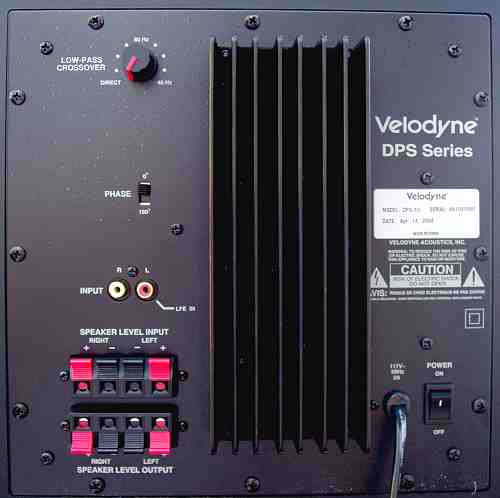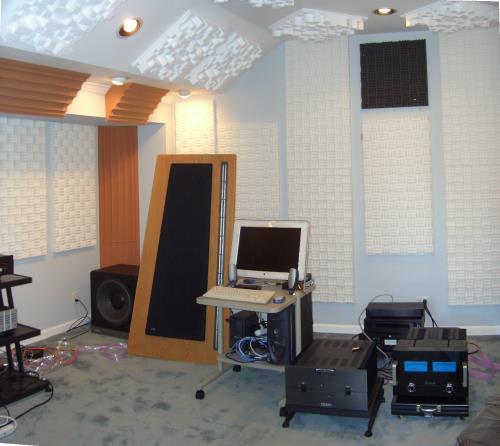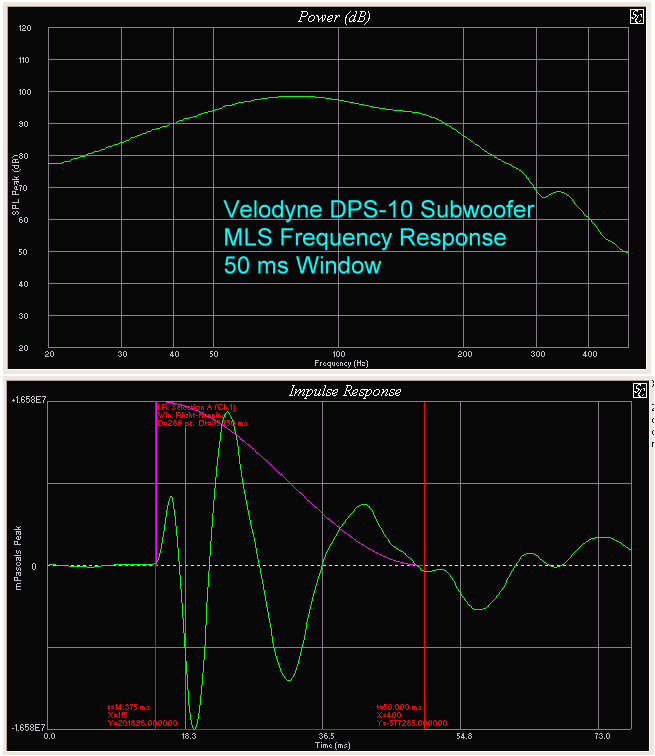|
|||||||||
|
Introduction With the release of the Velodyne DD18 Digital Drive Subwoofer, I just knew Velodyne would be ramping up for DSP in their other subs. Their new DPS (Digital Power Slot) series is just that. The enclosures are slot-loaded (the slot acts as a port), thus the word "Slot" in the series name. You can see the slot at the bottom of the front of the subwoofer, in the photo at the left. It extends all the way from the left side of the sub to to the right side. The word "Digital" refers to the DSP modes that the series has. The Design There are two subs in this series, the DPS-10 and DPS-12, using a 10" and 12" driver respectively. The slot-loading is tuned to deliver maximum bass in the deep frequencies for which subwoofers are designed, as opposed to the slot-loading that is found in full range speakers. The magnets on the drivers are heavy, and excursion is large, which is typical for Velodyne subwoofers. While the DD series uses DSP to adjust the room response, the DPS series uses DSP just for modes. Shown below is a diagram of the control panel that sits at the top, front edge of the subwoofer.
In the middle of the panel are volume control buttons, in icon form. Between those two buttons is the "Night Mode" button, which limits the maximum output for viewing in the evening, or when you are just not in the mood for loud bass. This saves having to adjust the volume manually. The blue LED goes dim when the Night Mode is on. Even in regular settings, the maximum output is limited so that it won't go into dangerous clipping. From the left to the right are buttons for the Movies Mode (maximum output and impact), R&B - Rock Mode (driving bass), Jazz - Classical Mode (pure and accurate), and Games Mode (hard hitting). Pressing these adjusts the contour of the bass. I could hear differences, but they were subtle. I decided to do all the testing in the Movies Mode, including the bench tests. The rear panel is pretty simple, with an On/Off toggle, input and output jacks, phase swith (00 or 1800) and the low-pass control. You can turn off the low-pass altogether by turning the control all the way in one direction to the "Direct" setting. This is for use when your processor is controlling the low-pass frequency, as many of them do these days. I performed the bench tests in this setting.
The amplifier is not huge by modern subwoofer standards, but it seemed powerful enough in our tests. The Sound I tested the DPS-10 in our lab, which has among other things, a Lexicon MC-12 SSP, Balanced Audio Power Amplifiers, McIntosh Power Amplifiers, Carver Amazing Ribbon Speakers, Thiel Audio CS2.4 Speakers, and cabling by Nordost and BetterCables. I also have two Velodyne F-1800 subwoofers in there, and will never let them leave (but of course, I turned them off for the DPS-10 tests). What struck me most about the DPS-10 is how tight the sound was. Because of the slot-loading vs. sealed enclosure, I thought it might be a little floppier than it turned out to be. But, tight is good, especially when listening to action movies, which is what I did with the DPS-10. Now, it won't match my F-1800s or HGS-18, but it did an amazing job for a 10" sub. Velodyne has the DPS-12 now, and I hope they expand the line to include a 15" version. I could hear a little rumble now and then, which is distortion in the 20 Hz range (see bench tests below), but for the most part, it sounded very clean, and with plenty of volume even for my large lab. For the Jurrasic Lunch scenes (8 Hz), no, but for Schwarzenegger and Stallone, oh yes! The Classical-Jazz Mode seemed to make the bass a little less intense than when in the Movies Mode, which I suppose is the intent. Otherwise, that string bass in the orchestra might sound overbearing. On the Bench I did these tests in the Movies Mode, with the microphone placed 10" from the driver. I measured a maximum SPL of 118 dB using a combination of 20 Hz, 31.5 Hz, and 50 Hz signals. At 20 Hz, THD was very high, obviously outside the intended range of this subwoofer. 98 dB was as loud as I could get it at 20 Hz.
At 25 Hz, however, THD came into very acceptable range at 100 dB output.
At 31.5 Hz, the THD was extremely low, but I suspect that part of this is due to room loading.
I do have extensive room treatments for the lab, as shown in the photo below. These include Sonex wall panels, Sonex bass traps, and RPG diffusors. Even so, this does not eliminate all the room effects which have to be taken into account when interpreting the results. Bumps in the 35 Hz range are common. You can cover every inch of a room's surface with absorbers and diffusors, which will give a flatter response, but then the room becomes so dead, it is unpleasant to listen to anything in there. So, room treatment is a compromise between reducing some of the room effects, but keeping it a comfortable listening environment.
At 40 Hz, THD was low, but higher than at 31.5 Hz, again, I think due to room loading at 31.5 Hz.
At 50 Hz, THD was well under control
The room response is shown below. I took a cumulative measurement, meaning that I moved the microphone around the room during the test, with the peak-holding feature turned on. You can see the loading in the 35 Hz range, which is what I mentioned above in the tests of individual sine waves. As an aside, the Velodyne DD series is designed specifically to reduce peaks such as in the graph below, and the process works very well. If I were using a DD18 on the response below, I would reduce the peak at 35 Hz and also the ones at 60 Hz and 80 Hz so the response was consistent with that in the 100 Hz to 200 Hz range. This would give a flat response from 180 Hz down to about 25 Hz. Not bad for $499! The other method is to place the subwoofer in relation to your sitting position so that the 35 Hz peak is minimized, but I wanted to show the cumulative graph that represents the worst case for this particular room.
The only accurate way to measure frequency response is by using an anechoic chamber, or if that is not available, the MLS technique, which filters the room response out. Below is the MLS frequency response. You can see that the maximum response is at about 80 Hz. Between 50 Hz and 25 Hz, the response falls by 15 dB. Frankly, I thought it would fall more than this, as the driver is only 10". Comparing the MLS quasi-anechoic response to the room response shown above, you can see how important the room is to the ultimate response that the subwoofer delivers to our ears at the sitting position The impulse response is positive in the first peak, corresponding to the 00 phase switch setting that I used.
Conclusions The Velodyne DPS-10 is an excellent performer, particularly for $499, and a first salvo (along with the DD series) in what promises to be the new world of digital subwoofers. I am sure other manufacturers will come out with their versions soon, but Velodyne has drawn first blood. Look for more digital subs from everyone in the next year or so. They just work too well to pass the technology up. The DPS-10 is compact, easy to use, incredibly priced, and delivers the goods. Lots of recommendation from JJ here. By the way, a DPS-10 is one of the prizes in our Secrets Forum Grand Opening Contest.
|
|||||||||














